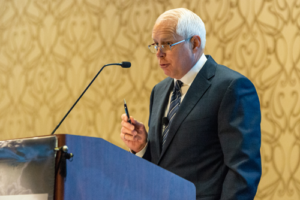Neveu: Enabling mindset, technologies, implementation to lead industry on journey to Drilling 4.0
By Linda Hsieh, Managing Editor, and Alex Wukman, Senior Editor
The industry is on the precipice of a paradigm shift, Kevin Neveu, President and CEO of Precision Drilling, said at the 2018 IADC Advanced Rig Technology Conference on 12 September in Austin, Texas. Drilling 4.0 as Mr Neveu called it, will be ushered in with the widespread adoption of big data practices, which will allow drilling contractors to eliminate performance variables and human bias. “Every foot drilled incorporates all the lessons learned from all the previous feet drilled,” he said. “We have to have better wells that are more consistent and more repeatable with lower cost.”
One the main challenges the industry faces in its ongoing transition towards a data-driven model is the legacy mindset – if it ain’t broke, don’t fix it. This risk aversion that’s ingrained into the industry can only be changed by strong executive leadership. “We have to think hard about centralized decision making and look at how we reduce the multiple levels of oversight and push decisions closer to the work face,” Mr Neveu said.

Challenges on the industry journey to Drilling 4.0 also exist around the industry’s structure, which is CAPEX-intensive with assets that have long lives and don’t lend themselves well to a new technology release every few months. Further, there’s the fragmented nature of the industry, which leads to different operating platforms and different data systems. “The fractured nature of the business makes it really hard to create standards, makes it hard to create platforms and move technology forward,” Mr Neveu said.
To overcome the obstacles in place and reach Drilling 4.0, Mr Neveu proposed that the industry needs three critical elements: an enabling mindset, enabling technologies and enabling implementation.
An enabling mindset, he noted, “is complete buy-in from leadership.” It also includes better collaboration among contractors, operators and suppliers, as well as effective and empowered project management. Further, the broader organization must be engaged in the change. “It does create some new roles and make obsolete some existing roles,” he said. Mr Neveu also added that, while aligned objectives are critical, that might not necessarily be done through performance-based contracts, which he said are more about trying to lower cost than to drive new technology adoption.
Enabling technologies will also be key in the industry’s transformation, and fortunately there are already strong technologies available to the industry that are providing the necessary data. Automation to take over many of the repetitive steps that the driller does in the driller’s chair will also help. “I don’t mean mechanizing,” Mr Neveu said. “I’m talking about the steps a driller takes around operating the drilling rig. We need to automate those repetitive steps and let the machine take over the timing and eliminate the human variances, eliminate the human bias.”
Once the mindset and technologies are in place, the industry will need to enable implementation, and the driller will play a central role in the digital drilling transformation. They will evolve from operating the rig to managing complex well construction processes. “We have to allow him to become a higher-level, more skilled worker on the rig,” Mr Neveu said. “They will be involved in real-time analytics, real-time decision making. If you can move those decisions away from the remote center closer to the driller, you will have a faster and more efficient operation.”





